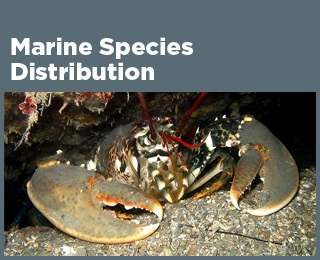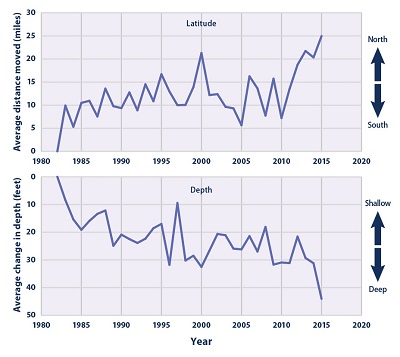|
|
| |
|
|
| |
|
|
| Marine Species Distribution |
|
| |
 Climate Change Indicators: Marine
Species Distribution Climate Change Indicators: Marine
Species Distribution
This indicator examines changes in the location of fish,
shellfish, and other marine species along U.S. coasts.
Key Points
The average center of biomass for 105 marine fish and
invertebrate species shifted northward by about 10 miles
between 1982 and 2015 (see Figure 1). These species also
moved an average of 20 feet deeper.
In waters off the northeastern United States, several
economically important species have shifted northward since
the late 1960s (see Figure 2). The three species shown in
Figure 2 (American lobster, red hake, and black sea bass)
have moved northward by an average of 119 miles.
In the Bering Sea, Alaska Pollock, snow crab, and Pacific
halibut have generally shifted away from the coast since the
early 1980s (see Figure 3). They have also moved northward
by an average of 14 miles. |
|
Background
Changes in water temperature can affect the environments
where fish, shellfish, and other marine species live.
Certain fish species naturally migrate in response to
seasonal temperature changes, moving northward or to deeper,
cooler waters in the summer and migrating back during the
winter. As climate change causes the oceans to become warmer
year-round (see the Ocean Heat and Sea Surface Temperature
indicators), however, populations of some species may adapt
by shifting away from areas that have become too warm and
toward areas that were previously cooler. Along U.S. coasts,
this means a shift northward or to deeper waters that may
have a more suitable temperature. As smaller prey species
shift their habitats, larger predator species may follow
them.
Marine species represent a particularly good indicator of
warming oceans because they are sensitive to climate and
because they have been studied and tracked for many years.
Fish are especially mobile, and they may shift their
location more easily than species on land because they face
fewer physical barriers. Also, many marine species,
especially fish, do not have fixed nesting places or
dwellings that might otherwise compel them to stay in one
place. Populations of many marine species have been measured
consistently for several decades across various types of
ocean habitats. Tracking data from many species is useful
because if a change in behavior or distribution occurs
across a large range of species, it is more likely the
result of a more systematic or common cause. |
|
About the Indicator
This indicator tracks marine animal species in terms of
their “center of biomass,” which is a point on the map that
represents the center of each species’ distribution by
weight. If a fish population were to shift generally
northward, the center of biomass would shift northward as
well. This approach is similar to the way changes in bird
population distributions have been measured (see the Bird
Wintering Ranges indicator).
Data for this indicator were collected by the National
Oceanic and Atmospheric Administration’s National Marine
Fisheries Service and other agencies. These agencies monitor
marine species populations by conducting annual surveys in
which they trawl the ocean at regular intervals along the
coast. By recording what they catch at each location,
scientists can calculate each species’ center of biomass in
terms of latitude, longitude, and depth.
This indicator focuses on two survey regions that have the
most continuous and longest-running sampling: the Northeast
and the eastern Bering Sea off the coast of Alaska. Figure 1
shows the average change in the center of biomass across 105
species in these regions. For consistency, Figure 1 is
limited to species that were identified every year. Figures
2 and 3 show detailed changes for three species in each
region. These species were chosen because they represent a
variety of habitats and species types (a mixture of fish and
shellfish) and because they tend to be fairly abundant. Some
of these species support major fisheries, yet are presumed
to not be heavily impacted by overfishing, reducing the
chance that fishing is unduly influencing the observed
trends. Northeast data come from surveys that have been
conducted every spring since 1968, while Bering Sea data
come from summer surveys that have been conducted
consistently since 1982.
Indicator Notes
Water temperature is not the only factor that can cause
marine animal populations to shift. Other factors could
include interactions with other species, harvesting, ocean
circulation patterns, habitat change, and species’ ability
to disperse and adapt. As a result, species might have moved
northward for reasons other than, or in addition to,
changing sea temperatures. This indicator is limited to the
Northeast and the eastern Bering Sea because these areas
have used consistent survey methods and because they do not
have coastlines that would prevent species from moving
northward in response to warming (in contrast to regions
like the Gulf of Mexico, where the coast blocks northward
migration).
Data Sources
Data for this indicator were collected by the National
Oceanic and Atmospheric Administration’s National Marine
Fisheries Service during annual bottom trawl fisheries
surveys. These data have been processed and made publicly
available by Rutgers University at:
https://oceanadapt.rutgers.edu. Data from these surveys
have been used to support a wide variety of studies.
Technical Documentation
Download related technical information PDF |
|
 Figure
1. Change in Latitude and Depth of Marine Species,
1982–2015 Figure
1. Change in Latitude and Depth of Marine Species,
1982–2015
This graph shows the annual change in latitude (movement in
miles) and depth (feet) of 105 marine species along the
Northeast coast and in the eastern Bering Sea. Changes in
the centers of biomass have been aggregated across all 105
species.
Data source: NOAA and Rutgers University, 20162 |
|
|
|
EPA Page |
|
This is the
EPA page for this topic. To see if the Trump
administration has changed the EPA page, simply click the
link and compare the information with this page. If you
notice changes were made to the EPA page, please post a
comment. Thanks. |
|
|
Figure 2. Average Location of Three Fish and Shellfish
Species in the Northeast, 1968–2015
This map shows the annual centers of biomass for three
species in the northeastern United States from 1968 to 2015.
Dots are shaded from light to dark to show change over time.
Data source: NOAA and Rutgers University, 20163
This indicator examines changes in the location of fish,
shellfish, and other marine species along U.S. coasts.
This map shows the annual centers of biomass for three
species in the eastern Bering Sea from 1982 to 2015. Dots
are shaded from light to dark to show change over time.
Data source: NOAA and Rutgers University, 20164 |
|
|
|
|
|
|
|
|
|
|
|
|
Additional Climate Change Information |
Climate Change and Carbon Dioxide
(Beginner - Listening,
reading)
A video lesson to
help with your understanding of climate change
and carbon dioxide.
The English is
spoken at 75% of normal speed.
Great English listening and reading practice. |
Carbon Dioxide and Climate Change
(Beginner - Listening,
reading)
A video lesson to
help with your understanding of carbon dioxide
and climate change.
The English is
spoken at 75% of normal speed.
Great English listening and reading practice. |
Environmental Group Warns Earth's Health at Risk
(Beginner - Listening,
reading)
A video lesson to
help with your understanding of climate change.
The English is
spoken at 75% of normal speed.
Great English listening and reading practice.
A report by the World Wildlife Fund looked at thousands of animal populations
and found they have dropped significantly in 40 years. |
Sea Levels Rising at Fastest Rate in 3,000 years
(Beginner - Listening,
reading)
A video lesson to
help with your understanding of climate change.
The English is
spoken at 75% of normal speed.
Great English listening and reading practice.
A group of scientists say sea levels are rising at record rates. Another group
found that January temperatures in the Arctic reached a record high. |
Capturing CO2 Gas Is Not Easy
(Beginner - Listening,
reading)
A video lesson to
help with your understanding of climate change.
The English is
spoken at 75% of normal speed.
Great English listening and reading practice.
Most scientists agree that carbon-dioxide gas is partly to blame for climate
change: rising global temperatures. But capturing the CO2 gas released by power
stations is costly and difficult. |
Growth, Climate Change Threaten African Plants and
Animals
(Beginner - Listening,
reading)
A video lesson to
help with your understanding of climate change.
The English is
spoken at 75% of normal speed.
Great English listening and reading practice.
Researchers believe Africa may lose as much as 30 percent of its animal and
plant species by the end of this century. |
|
|
|
|
Search Fun Easy English |
|
|
|
|
|
|
|
|
|
|
|
|
|
|
|
About
Contact
Copyright
Resources
Site Map |